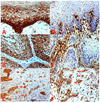Tumor budding correlates with poor prognosis and epithelial-mesenchymal transition in tongue squamous cell carcinoma
- PMID: 21481005
- PMCID: PMC3135705
- DOI: 10.1111/j.1600-0714.2011.01041.x
Tumor budding correlates with poor prognosis and epithelial-mesenchymal transition in tongue squamous cell carcinoma
Abstract
Background: Tumor budding is a readily detectable histopathological feature and has been recognized as an adverse prognostic factor in several human cancers. However, the prognostic value of tumor budding in tongue squamous cell carcinoma (TSCC) has not been reported. The purpose of this study was to assess the correlation of tumor budding with the clinicopathologic features, and the known molecular biomarkers (E-cadherin and Vimentin), as well as to evaluate its prognostic significance for TSCC.
Methods: Archival clinical samples of 230 patients with TSCC were examined for tumor budding. Immunohistochemistry analyses were performed to examine the expression of E-cadherin and Vimentin. Statistical analyses were carried out to assess the correlation of tumor budding with clinicopathologic parameters and patient survival. The potential association between tumor budding and alterations of E-cadherin and Vimentin expression was also assessed.
Results: Of the 230 TSCC cases examined, tumor budding was observed in 165 cases (71.7%), with a mean tumor bud count of 7.5 (range from 1 to 48 buds). High-intensity budding (≥5 tumor buds) was observed in 111 cases (48.3%). Statistical analysis revealed that tumor budding was associated with tumor size (P < 0.05), differentiation (P < 0.05), clinical stage (P < 0.05), lymph node metastasis (P < 0.01), and correlated with reduced overall survival. In addition, significant associations were observed among tumor budding and the deregulation of E-cadherin (P < 0.001) and Vimentin (P < 0.001).
Conclusions: Tumor budding, which associates with epithelial-mesenchymal transition, is a frequent event and appears to be an independent prognostic factor in TSCC.
© 2011 John Wiley & Sons A/S.
Conflict of interest statement
Figures



Similar articles
-
A role for cancer-associated fibroblasts in inducing the epithelial-to-mesenchymal transition in human tongue squamous cell carcinoma.J Oral Pathol Med. 2014 Sep;43(8):585-92. doi: 10.1111/jop.12172. Epub 2014 Mar 20. J Oral Pathol Med. 2014. PMID: 24645915
-
Tumor budding correlates with occult cervical lymph node metastasis and poor prognosis in clinical early-stage tongue squamous cell carcinoma.J Oral Pathol Med. 2015 Apr;44(4):266-72. doi: 10.1111/jop.12242. Epub 2014 Aug 28. J Oral Pathol Med. 2015. PMID: 25169851
-
α-Smooth muscle actin-positive myofibroblasts, in association with epithelial-mesenchymal transition and lymphogenesis, is a critical prognostic parameter in patients with oral tongue squamous cell carcinoma.J Oral Pathol Med. 2014 May;43(5):335-43. doi: 10.1111/jop.12143. Epub 2013 Dec 9. J Oral Pathol Med. 2014. PMID: 24313357
-
Vimentin is a potential prognostic factor for tongue squamous cell carcinoma among five epithelial-mesenchymal transition-related proteins.PLoS One. 2017 Jun 1;12(6):e0178581. doi: 10.1371/journal.pone.0178581. eCollection 2017. PLoS One. 2017. PMID: 28570699 Free PMC article.
-
Overexpression of Hippo pathway effector TAZ in tongue squamous cell carcinoma: correlation with clinicopathological features and patients' prognosis.J Oral Pathol Med. 2013 Nov;42(10):747-54. doi: 10.1111/jop.12062. Epub 2013 Mar 29. J Oral Pathol Med. 2013. PMID: 23551691
Cited by
-
A Study of the Prognostic Factors for Late Cervical Lymph Node Metastasis and Distant Metastasis in Patients with cT1-2N0 Tongue Cancer.J Clin Med. 2024 Feb 8;13(4):976. doi: 10.3390/jcm13040976. J Clin Med. 2024. PMID: 38398289 Free PMC article.
-
Comparison of Clinico-Demographic and Histological Parameters Between Young and Old Patients With Oral Squamous Cell Carcinoma.Cureus. 2023 Nov 1;15(11):e48137. doi: 10.7759/cureus.48137. eCollection 2023 Nov. Cureus. 2023. PMID: 38046721 Free PMC article.
-
Tumour budding in solid cancers.Nat Rev Clin Oncol. 2021 Feb;18(2):101-115. doi: 10.1038/s41571-020-0422-y. Epub 2020 Sep 8. Nat Rev Clin Oncol. 2021. PMID: 32901132 Review.
-
Current and Emerging Diagnostic, Prognostic, and Predictive Biomarkers in Head and Neck Cancer.Biomedicines. 2024 Feb 10;12(2):415. doi: 10.3390/biomedicines12020415. Biomedicines. 2024. PMID: 38398017 Free PMC article. Review.
-
Lymphatic Vascular Density, the Expression of Podoplanin and Tumor Budding in Oral Squamous Cell Carcinoma.Head Neck Pathol. 2023 Jun;17(2):371-382. doi: 10.1007/s12105-022-01511-z. Epub 2022 Dec 8. Head Neck Pathol. 2023. PMID: 36480090 Free PMC article.
References
-
- Jemal A, Siegel R, Xu J, Ward E. Cancer statistics, 2010. CA Cancer J Clin. 2010;60:277–300. - PubMed
-
- Lydiatt DD, Robbins KT, Byers RM, Wolf PF. Treatment of stage I and II oral tongue cancer. Head Neck. 1993;15:308–312. - PubMed
-
- Yuen AP, Lam KY, Chan AC, et al. Clinicopathological analysis of elective neck dissection for N0 neck of early oral tongue carcinoma. Am J Surg. 1999;177:90–92. - PubMed
-
- Layland MK, Sessions DG, Lenox J. The influence of lymph node metastasis in the treatment of squamous cell carcinoma of the oral cavity, oropharynx, larynx, and hypopharynx: N0 versus N+ Laryngoscope. 2005;115:629–639. - PubMed
-
- Teichgraeber JF, Clairmont AA. The incidence of occult metastases for cancer of the oral tongue and floor of the mouth: treatment rationale. Head Neck Surg. 1984;7:15–21. - PubMed
Publication types
MeSH terms
Substances
Grants and funding
LinkOut - more resources
Full Text Sources

